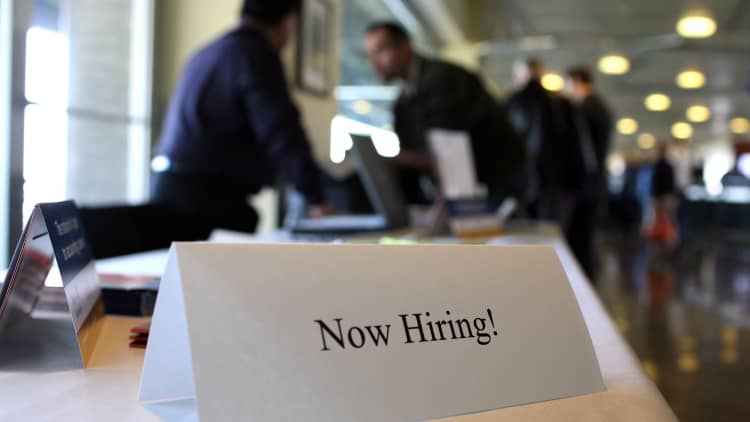
Nonfarm payrolls rose 103,000 in March while the unemployment rate was 4.1 percent, falling well short of Wall Street expectations during a month where weather caused havoc on the jobs market, according to a Bureau of Labor Statistics report Friday.
Economists had been expecting a payrolls gain of 193,000 and the unemployment rate to decline one-tenth of a point to 4 percent. The monthly reading was a huge slip from the 326,000 reported in February.
A broader measure of unemployment that includes discouraged workers and those holding part-time positions for economic reasons — the underemployed — fell two-tenths of a point to 8 percent, its lowest reading in 11 years.
"If one were to only focus on this single month, the March employment report is on the disappointing side," said Mark Hamrick, senior economic analyst at Bankrate.com. "Broader context is appropriate, however. The job market is widely regarded to be close to full employment. So, hiring gains should be slowing at this point in the expansion."
In addition to the payrolls news, the closely watched average hourly earnings figure rose 0.3 percent, against estimates of 0.2 percent. The number equates to a healthy but not worrisome 2.7 percent rate on an annualized basis. The average work week was unchanged at 34.5 hours.
Stock market reaction to the report was muted, with major indexes lower largely on renewed worries over a U.S. trade war with China.
"Wage growth continues to inch higher but not enough to worry markets at this point," said Quincy Krosby, chief market strategist at Prudential Financial. "As we move closer and closer towards full employment expectations are that headline employment should slow. This number reflects a continued reversion to the mean."
Professional and business services led with 33,000 new jobs while manufacturing and health care added 22,000 new jobs apiece. Mining rose 9,000 while construction lost 15,000 positions and retail fell 4,000.
In addition to the weak March growth, January's total was revised down from 239,000 to 176,000, though February got a boost from 313,000 to 326,000.
The wide swings in monthly numbers "is a good illustration of the inherent volatility in the nonfarm payroll data," said Paul Ashworth, chief U.S. economist at Capital Economics. "The March gain was the worst in six months. The February gain was the best in 2½ years."
Job creation skewed heavily to part time, which rose by 310,000 while full-time positions fell by 311,000, according to the household survey.
The March government number differed strongly from an ADP/Moody's Analytics reading earlier this week that showed private payrolls up by 241,000. The BLS report indicated that all but 1,000 of the new jobs came from the private sector.
"Weather disruptions played a key role in the weak reading," said Beth Ann Bovino, U.S. chief economist at S&P Global Ratings. "One million jobs were disrupted because of weather in March. Translating that to payrolls means a lot of people weren't counted."
Weather distortions are common for March, which saw just 78,000 jobs added in 2015 and 73,000 in 2017. March 2009 also was the worst month for job losses during the Great Recession with a plunge of 802,000.
Labor force participation slipped to 62.9 percent as those considered not in the labor force jumped by 323,000 to 95.3 million.
The report comes amid a series of mixed signals for the economy.
Data earlier this week showed factory orders on the rise though spending is slowing. Consumer sentiment is at a 14-year high, but worries are percolating over a brewing trade war between the U.S. and China.
Federal Reserve policymakers watch the jobs number closely. The central bank is widely expected to hike its benchmark interest rate in June and at least once more before the end of the year. The Fed is keeping an especially close eye on wages for signs of inflation.


